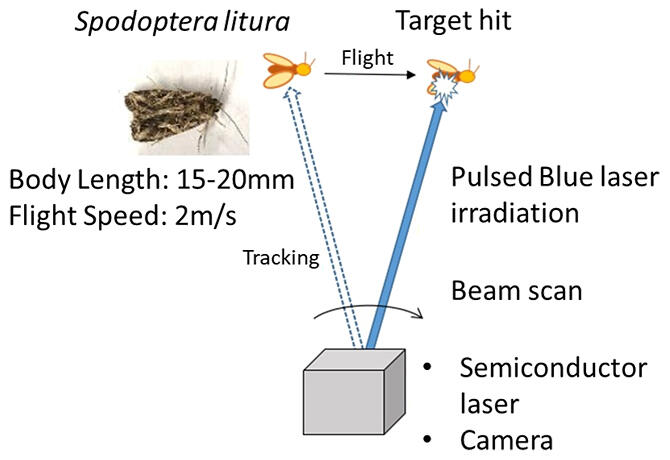The value of global crop production is estimated at 165 trillion yen. Unfortunately, 26 trillion yen of this is lost due to damage caused by pests and vermin. To minimize environmental impacts, it is important to avoid chemical extermination methods whenever possible.
A research group led by Specially Appointed Professor Hiroshi Fuji and Professor Kazuhisa Yamamoto at Osaka University's Institute of Laser Engineering has achieved a world first by discovering where pests are most vulnerable to extermination using laser beams. The target pest in this study was the Spodoptera litura moth, a species known for its resistance to chemicals and the significant damage it causes to crops. The researchers discovered that the moths' thorax and face were vulnerable and confirmed that they could be eliminated using a prototype laser and tracking device.

Provided by Osaka University
Yamamoto said, 'Our goal is to improve agricultural production rates and promote pesticide‐free agriculture. The National Agriculture and Food Research Organization's (NARO) Moonshot team is currently developing AI‐based flight prediction software, with plans to combine it with the laser extermination method, aiming for practical use around 2025. Using lasers to eliminate pests such as the desert locust, which cause significant damage in Africa and other regions, could also provide a source of insect‐based food.'
Previous research on pest control using lasers was limited to small insects such as mosquitoes, but larger insects required too much energy.
The current research team applied blue semiconductor laser beams locally to various parts of Spodoptera litura to assess the level of damage and found that the thorax and face were more susceptible to damage. Targeting these vulnerable areas made it possible to eliminate the moths with relatively low energy requirements. These findings were also confirmed in domestic grasshoppers, which are similar to the desert locust.
Flying Spodoptera litura were also successfully tracked and exterminated using pulsed light from a blue semiconductor laser.
Fuji commented, 'We employ a conventional motion detection device to track pests and direct a weak laser beam to the center of their bodies. However, our goal is to find a way to target their vital spots when their underbody faces us, leading to more efficient extermination. It's important to note that the size difference between pests and humans makes accidental harm unlikely. Even if hit, the laser beam only causes a slight warming effect, and even the damage it could cause to crops exceeds nothing more than an insect bite. In the future, we aim to create a system that can effectively eliminate pests such as cockroaches and flies, among others.'
This article has been translated by JST with permission from The Science News Ltd. (https://sci-news.co.jp/). Unauthorized reproduction of the article and photographs is prohibited.




